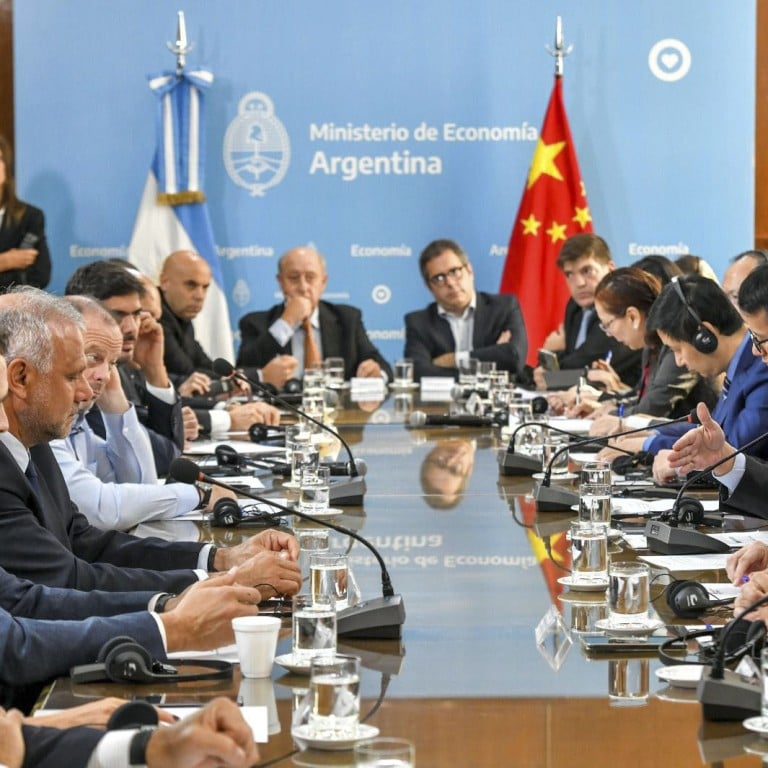
Argentina to settle Chinese imports in yuan as China marches into South America to dethrone US dollar
- Argentina will pay for US$1.04 billion of Chinese imports in April in yuan instead of US dollars and then US$790 million per month from May
- The yuan has, according to Bloomberg, surpassed the US dollar for the first time in cross-border transaction in China amid increasing de-dollarisation efforts
China’s push for greater use of its currency in bilateral trade settlements has made further inroads in South America, with Argentina set to follow Brazil and start to pay for Chinese imports in yuan rather than US dollars.
Economy Minister Sergio Massa confirmed on Wednesday that Argentina, following a meeting with Chinese ambassador Zou Xiaoli and companies from various sectors, had “activated the swap with China”.
Argentina will, Massa added, pay for US$1.04 billion of Chinese imports in April in yuan instead of US dollars and then US$790 million per month from May.
The second-largest country in South America is attempting to maintain its reserves of US dollars after a historic drought reduced exports by US$15 billion, including from its key agricultural sector.
China is confident towards the economic and financial stability of Argentina, as well as its future development
“These types of measures give our reserves greater strength and are key to improving the prospects for net reserves, giving us greater freedom and capacity to intervene in the face of those who speculate and overspeculate with the economic situation,” he added on his official Twitter account.
In January, the People’s Bank of China expanded its currency swap agreement with Argentina by 35 billion yuan (US$5 billion) to 165 billion yuan.
“China is willing to further enhance the current swap cooperation under the currency framework as a support to yuan settlements in Argentina,” Zou said on the official WeChat account of the Chinese embassy in Buenos Aires.
“China is confident towards the economic and financial stability of Argentina, as well as its future development.”
The yuan has, according to Bloomberg, surpassed the US dollar for the first time in cross-border transaction use in China.
The proportion of yuan used in China’s cross-border transactions rose to 48 per cent in March from close to zero in 2010, while use of the US dollar has dropped from 83 per cent to 47 per cent during the same period, the Bloomberg figures showed.
The yuan has surpassed the euro to become Brazil’s second-largest international reserve currency after the US dollar.
How China’s yuan stands to gain with US Fed’s tightening ‘coming to an end’
And on Wednesday during a speech in Spain, Lula further added his support to the establishment of a currency “just like the Europeans created the euro” for trade between BRICS countries.
Zhou Hao, chief economist at Guotai Junan International, wrote in a recent report that the US Federal Reserve entering into an “aggressive tightening process due to inflation concerns” since the outbreak of the coronavirus had helped boost the use of yuan.
“As a result, the issuance of [offshore yuan] bonds surged over the past few years reflecting this regime change.
“The game changer, in our opinion, is the [yuan] settlement agreement between China and its trade partners, particularly the commodity exporters for China.”
China, which is the world’s largest merchandise exporter with a share of around 15 per cent, could use its trade deficits with the likes of Australia, Brazil, Russia and Indonesia to give yuan internationalisation a chance to expand, said Zhou.
Zhou also suggested that yuan available in sovereign wealth funds could be invested back to the offshore, or even onshore, yuan markets.
“If these [yuan] funds can be invested back to [the offshore] market or even onshore China markets, this will create a great recycling process for [yuan],” he added.
“During this process, the yuan internationalisation will be rapidly promoted.”
He noted that the recycling process would be “similar to the dollar recycling process for now” as countries running a trade surplus against the United States will have US dollar funds available that ultimately go back to US dollar-denominated financial assets.

